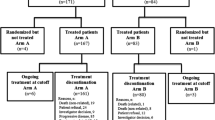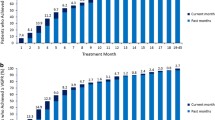Abstract
Thal–dex (TD) is an effective therapy for advanced MM. We evaluated TD as salvage treatment of MM patients at first relapse. Thal was given at a daily dose of 100 or 200 mg until progression. Dex was administered 160 mg/month. One hundred patients were enrolled. First line therapy included ASCT (72%) and conventional CHT (28%). Fifty-nine percent received a fixed thal dose of 100 mg/day. The most frequent adverse events were constipation (42%), peripheral neuropathy (58%, 5% grade 3), bradycardia (20%), skin rash (11%), and VTE (7%). Discontinuation of thal due to adverse events was recorded in eight patients. On ITT, 46% of patients achieved at least a PR. Median DOR was 28 months, median time to next therapy was 15.5 months. Median OS, TTP, and PFS were 43, 22, and 21 months, respectively. TTP and PFS were significantly longer for patients with at least PR to TD. TD was an effective salvage treatment for MM patients at first relapse, as demonstrated by durable disease control and prolonged OS. TD was well tolerated, as reflected by the long stay on treatment without disease progression (median 25 months) and a low discontinuation rate due to toxicity (8%).





Similar content being viewed by others
References
Kyle RA, Rajkumar SV (2004) Multiple myeloma. N Engl J Med 351:1860–1873
Attal M, Harousseau JL, Stoppa AM et al (1996) A prospective, randomized trial of autologous bone marrow transplantation and chemotherapy in multiple myeloma. Intergroupe Francais du Myelome. N Engl J Med 335(2):91–97
Child JA, Morgan GJ, Davies FE et al (2003) High-dose chemotherapy with hematopoietic stem-cell rescue for multiple myeloma. N Engl J Med 348(19):1875–1883
Kumar SK, Rajkumar V, Dispenzieri A et al (2008) Improved survival in multiple myeloma and the impact of novel therapies. Blood 111(5):2516–2520
Singhal S, Metha J, Desikan R et al (1999) Antitumor activity of thalidomide in refractory multiple myeloma. N Engl J Med 341(21):1565–1571
Glasmacher A, Hahn C, Hoffmann F et al (2006) A systematic review of phase-II trials of thalidomide monotherapy in patients with relapsed or refractory multiple myeloma. Br J Haematol 132(5):584–593
Von-Lilienfeld-Toal M, Hahn-Ast C, Furkert K et al (2008) A systematic review of phase II trials of thalidomide–dexamethasone combination in patients with relapsed or refractory multiple myeloma. Eur J Haematology 81:247–252
Palumbo A, Facon T, Sonneveld P et al (2008) Thalidomide for treatment of multiple myeloma: 10 years later. Blood 111(8):3968–3977
Bladè J, Samson D, Reece D et al (1998) Criteria for evaluating disease response and progression in patients with multiple myeloma treated by high-dose therapy and haemopoietic stem cell transplantation. Br J Haematol 102:1115–1123
Cavo M, Zamagni E, Cellini C et al (2002) Deep vein thrombosis in patients with multiple myeloma receiving first-line thalidomide–dexamethasone therapy. Blood 100(6):2272–2273
Cavo M, Di Raimondo F, Zamagni E et al (2009) Short-term thalidomide incorporated into double autologous stem-cell transplantation improves outcomes in comparison with double autotransplantation for multiple myeloma. J Clin Oncol 27(30):5001–5007
Corso A, Zappasodi P, Barbarano L et al (2009) Long-term outcome in relapsed and refractory multiple myeloma treated with thalidomide. Balancing efficacy and side-effects. Leuk Res 33(9):e145–e149
Tosi P, Zamagni E, Cellini C et al (2002) Salvage therapy with thalidomide in patients with advanced relapsed/refractory multiple myeloma. Haematologica 87(4):408–414
Dimopoulos M, Spencer A, Attal M et al (2007) Lenalidomide plus dexamethasone for relapsed or refractory multiple myeloma. N Engl J Med 357(21):2123–2132
Stadtmauer EA, Weber D, Niesvizky R et al (2009) Lenalidomide in combination with dexamethasone at first relapse in comparison with its use as later salvage therapy in relapsed or refractory multiple myeloma. Eur J Haematol 82:426–432
Richardson PG, Sonneveld P, Schuster MW et al (2005) Bortezomib or high-dose dexamethasone for relapsed multiple myeloma. N Engl J Med 352(24):2487–2498
Richardson PG, Sonneveld P, Schuster M et al (2007) Extended follow-up of a phase 3 trial in relapsed multiple myeloma: final time-to-event results of the APEX trial. Blood 110(10):3557–3560
Richardson PG, Sonneveld P, Schuster MW et al (2007) Safety and efficacy of bortezomib in high-risk and elederly patients with relapsed multiple myeloma. Br J Haematol 137:429–435
Yakoub-Agha I, Doyen C, Hulin C et al (2006) A multicenter prospective randomised study testing non inferiority of thalidomide 100mg/day as compared with 400mg/day in patients with refractory/relapsed multiple myeloma: results of the final analysis of the IFM-02 study. J Clin Oncol 24:7520
Van Rhee F, Dhodapkar M, Shaughnessy JD et al (2008) First thalidomide clinical trial in multiple myeloma: a decade later. Blood 112(4):1035–1038
Tosi P, Zamagni E, Cellini C et al (2005) Neurological toxicity of long-term (>1 yr) thalidomide therapy in patients with multiple myeloma. Eur J Haematol 74(3):212–216
Offidani M, Corvatta L, Marconi M et al (2004) Common and rare side-effects of low-dose thalidomide in multiple myeloma: focus on dose-minimazing peripheral neuropathy. Eur J Haematol 72:403–409
Plasmati R, Pastorelli F, Cavo M et al (2007) Neuropathy in multiple myeloma treated with thalidomide: a prospective study in patients with newly diagnosed multiple myeloma. Neurology 69:573–581
Hussein M, Bolejack V, Zonder JA et al (2009) Phase II study of thalidomide plus dexamethasone induction followed by tandem melphalan-based autotransplantation and thalidomide plus prednisone maintenance for untreated multiple myeloma: a southwest Oncology Group Trial (SO204). J Clin Oncol 27(21):3510–3517
Cavo M, Pantani L, Tacchetti P et al (2009) Thalidomide maintenance in multiple myeloma: certainties and controversies. J Clin Oncol 27(32):e186–e187
Chang JE, Juckett MB, Callander NS et al (2008) Thalidomide maintenance following high-dose melphalan with autologous stem cell support in myeloma. Clin Lymphoma Myeloma 8(3):153–158
Spencer A, Prince HM, Roberts AW et al (2009) Consolidation therapy with low-dose thalidomide and prednisolone prolongs the survival of multiple myeloma patients undergoing a single autologous stem-cell transplantation procedure. J Clin Oncol 27(11):1788–1793
San Miguel JF, Dimopoulos MA, Stadtmauer EA et al (2010) Effects of lenalidomide and dexamethasone treatment duration on survival in patients with relapsed or refractory multiple myeloma treated with lenalidomide and dexamethasone. Clin Lymphoma Myeloma Leuk 120:1–6
Von Lilienfeld-Toal M, Hahn-Ast C, Bertolini F et al (2007) Longer duration of thalidomide monotherapy results in improved outcome in relapsed/refractory multiple myeloma. Blood 110:800a
Morgan GJ, Jackson GH, Davies F et al (2008) Maintenance thalidomide may improve progression free survival but not overall survival; results from the myeloma XI maintenance randomisation. Blood 112:656a
Morgan GJ, Davies FE, Gregory WM et al (2010) Thalidomide maintenance significantly improves progression free survival (PFS) and overall survival (OS) of myeloma patients when effective relapse treatments are used: MRC myeloma IX results. Blood 116:623a
All the authors declare no relevant competing financial interests.
Author information
Authors and Affiliations
Corresponding author
Rights and permissions
About this article
Cite this article
Zamagni, E., Petrucci, A., Tosi, P. et al. Long-term results of thalidomide and dexamethasone (thal–dex) as therapy of first relapse in multiple myeloma. Ann Hematol 91, 419–426 (2012). https://doi.org/10.1007/s00277-011-1320-2
Received:
Accepted:
Published:
Issue Date:
DOI: https://doi.org/10.1007/s00277-011-1320-2




